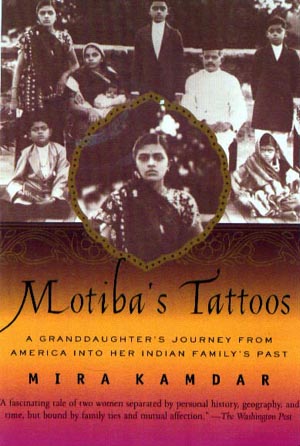|
Motiba's
Tattoos
About
Reviews
|
Motiba's Tattoos
A Granddaughter's Journey from America into Her Indian
Family's Past
MIRA KAMDAR
|
Mira Kamdar was bom in the United
States to an Indian father and a Danish-American mother. Like
many Americans, she found herself yearning to know more about
her unique past and her family's identity. In MOTIBA'S TATTOOS:
A Granddaughter's Journey into her Indian Family's Past (A Plume
Book; On-Sale Date: September 4, 2001), Kamdar invites us on her
quest to rediscover her Indian roots, as she traces her family's
journey from an isolated comer of India to post-modem California.
When Mira Kamdar's Motiba - an
Indian word for "grandmother" - died, she realized that a whole
world disappeared with her. Motiba was marked with mysterious
signs from a lost era: geometric tattoos on her face and forearms.
What did these symbols mean? When had they been etched? Why? Haunted
by the riddle of Motiba's tattoos and moved by the loss of her
grandmother, Kamdar began her tracing the hazy, twisting corridors
of the past.
Beginning.with the life story
of her Motiba, Kamdar follows her family from feudal, rural 1900s
India to the bustling streets of Rangoon in the 1920s and 30s.
When' Japan bombs the city in 1941, the family flees to Bombay,
where they get their first taste of American life in the sumptuous
Art Deco movie houses there. Seduced by Hollywood's fantastic
portrayal of post-war American life, Kamdar's 19-year-old father
sets off for the United States in the 1950s, marking the
|
 |
of the family's westward emigration, and their subsequent
struggle with multiethnic identity in the late twentieth century.
With rich, vivid details other relatives'
fascinating lives, complete with family recipes, photos, and maps, MOTIBA'S
TATTOOS deftly evokes the moods and atmospheres of lost times and places.
The deeper she delves, the more Kamdar realizes that her family's story
is part of a much larger saga. It is one version of the great story
of the twentieth century - the story of leaving home, of severing roots,
of losing one's tribe. Told in rich, lyrical language, Kamdar's story
becomes the story of every family who has ever assimilated into a new
culture.
About the Author
Mira Kamdar is a Senior Fellow
at the World Policy Institute at the New School
University. She has written for the Los Angeles Times, the Chicago Tribune,
and World
Policy Journal. Currently at work on a novel, she divides her time between
New York
City and Vancouver, Washington.
4 Selected for the Bames & Noble Discover Great New Writers Program.
4 Chosen by The Oregonian as one of the "Top Ten Books of 2000" by a
regional
author.
4. Online Reading Group Guide Available at www.penguinputnam.com
Visit MOTIBA 'S TATTOOS on the web at www.motibastattoos.com
|

